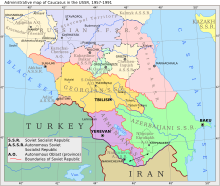
Back جمهورية الشيشان - إنغوشيا الاشتراكية السوفيتية المتمتعة بالحكم الذاتي Arabic República Autónoma Socialista Soviética de Chechenia-Ingushia AST Чачан-Гъалгъай Автономияб Советияб Социализмаялъул Республика AV Çeçen-İnquş Muxtar Sovet Sosialist Respublikası Azerbaijani Чачэна-Інгушская Аўтаномная Савецкая Сацыялістычная Рэспубліка Byelorussian Чачэна-Інгуская АССР BE-X-OLD Чечено-ингушка автономна съветска социалистическа република Bulgarian OE Tchetchenia-Ingouchetia Breton República Socialista Soviètica Autònoma de Txetxènia-Ingúixia Catalan Нохч-ГӀалгӀайн Автономин Советийн Социалистийн Республика CE
This article needs additional citations for verification. (November 2008) |
| Chechen Autonomous Oblast (1922–1934) Ingush Autonomous Oblast (1924–1934) Checheno-Ingush Autonomous Oblast (1934–1936) Checheno-Ingush Autonomous Soviet Socialist Republic (1936–1944, 1957–1993) | |||||||||||||||||||
|---|---|---|---|---|---|---|---|---|---|---|---|---|---|---|---|---|---|---|---|
| Autonomous oblast of the RSFSR ASSR of the Russian SFSR Republic of the Russian Federation | |||||||||||||||||||
| 1922–1944 1957–1993 | |||||||||||||||||||
 Map of the Soviet Caucasus including the Checheno-Ingush ASSR | |||||||||||||||||||
| Anthem | |||||||||||||||||||
| "My Checheno-Ingushetia" Чечено-Ингушетия Моя | |||||||||||||||||||
| Capital | Grozny | ||||||||||||||||||
| Demonym |
| ||||||||||||||||||
| Government | |||||||||||||||||||
| • Motto | Ерриг Пачхьалкхийн Пролетареш, Цхьаьнакхета! (Workers of the world, unite!) | ||||||||||||||||||
| Historical era | 20th century | ||||||||||||||||||
• Chechen Autonomous Oblast formed | 30 November 1922 | ||||||||||||||||||
• Ingush Autonomous oblast formed | 7 July 1924 | ||||||||||||||||||
| 15 January 1934 | |||||||||||||||||||
• Elevation into an ASSR | 5 December 1936 | ||||||||||||||||||
| 7 March 1944 | |||||||||||||||||||
• Autonomous Republic restored | 9 January 1957 | ||||||||||||||||||
• Sovereignty declared | 27 November 1990 | ||||||||||||||||||
• Renamed the Checheno-Ingush Republic | 16 May 1992 | ||||||||||||||||||
| June 1992 | |||||||||||||||||||
• Dissolved | 9 January 1993 | ||||||||||||||||||
| Contained within | |||||||||||||||||||
| • Country | Soviet Union (1922–1991) Russian Federation (1991–1993) | ||||||||||||||||||
| |||||||||||||||||||
| Today part of | Russia · Chechnya · Ingushetia | ||||||||||||||||||
When the Soviet Union existed, different governments had ruled the southern Caucasus regions of Chechnya and Ingushetia. Within the Mountain Autonomous Socialist Soviet Republic, later annexed into the Russian Socialist Federative Soviet Republic, they were known as the Chechen Autonomous Oblast[a] and the Ingush Autonomous Oblast,[b] which were unified on January 15, 1934, to form the Checheno-Ingush Autonomous Oblast.[c][2][3][full citation needed][4] It was elevated to an autonomous republic as the Checheno-Ingush Autonomous Soviet Socialist Republic[d] from 1936 to 1944 and again from 1957 to 1993. Its capital was Grozny.
However, because of alleged collaboration with Nazi Germany and the Axis powers during World War II, the autonomous republic was abolished on 7 March 1944 resulting the ethnic cleansing of the Chechens and Ingush from its territory. The autonomous republic's status was restored in January 1957. The 1979 census reported the territory had an area of 19,300 square kilometres (7,500 sq mi) and a population of 1,155,805 (1979 Census):[5] 611,405 Chechens, 134,744 Ingush, and the rest were Russians and other ethnic groups.[5]
- ^ Heaney, Dominic; McIntyre, Philip, eds. (2013). The Territories of the Russian Federation 2013 (14th ed.). Oxfordshire: Routledge. p. 39. ISBN 9781857436754. ISSN 1465-461X.
- ^ Всероссийский Центральный Исполнительный Комитет. Декрет от 30 ноября 1922 г. «Об образовании автономной области Чечни». (All-Russian Central Executive Committee. Decree of November 30, 1922 On the Establishment of the Autonomous Oblast of Chechnya. ).
- ^ Большая советская энциклопедия. 1937.
{{cite encyclopedia}}: Missing or empty|title=(help) - ^ Askerov, Ali (22 April 2015). Historical Dictionary of the Chechen Conflict. Lanham: Rowman & Littlefield. p. 76. ISBN 9781442249257 – via Google Books.
- ^ a b "Всесоюзная перепись населения 1979 г. Национальный состав населения по регионам России" [All Union Population Census of 1979. Ethnic composition of the population by regions of Russia.]. Demoscope Weekly (website of the Institute of Demographics of the State University—Higher School of Economics) (in Russian). 1979. Retrieved 25 November 2008.
Cite error: There are <ref group=lower-alpha> tags or {{efn}} templates on this page, but the references will not show without a {{reflist|group=lower-alpha}} template or {{notelist}} template (see the help page).
© MMXXIII Rich X Search. We shall prevail. All rights reserved. Rich X Search

